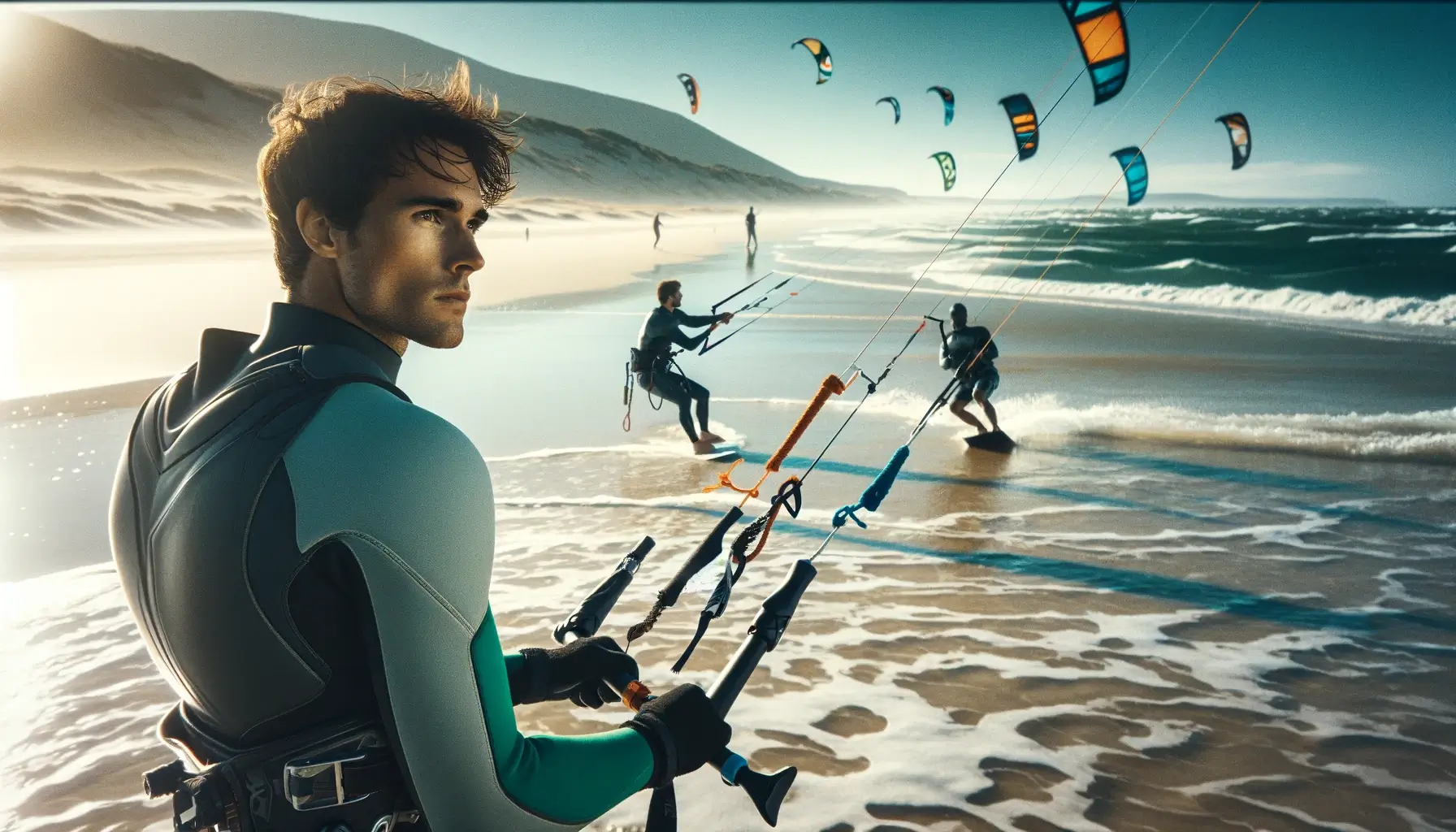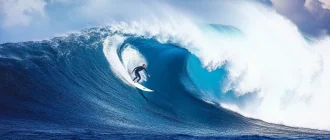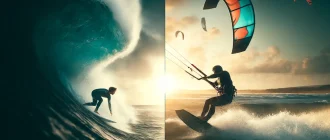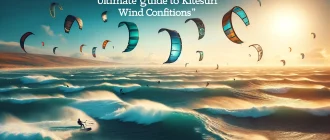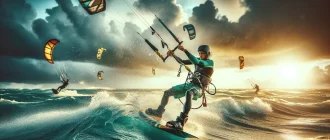Are you wondering how long it takes to learn to kitesurf? On average, it takes most people between 6 to 12 hours of lessons over a few sessions and days up to a week to get to a basic level of proficiency, although complete independence may take longer.
This time can vary widely due to factors such as physical fitness, coordination, consistency of practice, and the quality of instruction. But how long does it take to learn to kitesurf?
Our guide delves into the journey of a kitesurf posted becoming an independent kitesurfer, examining the stages of the learning curve, what can affect your pace, and how to potentially expedite your progress.
Key Takeaways
- Learning to kitesurf is progressive. It starts with mastering kite control on land, practicing body dragging in the water, and developing basic riding skills to achieve independence.
- Several factors affect the learning pace, including the individual’s physical and cognitive processes, the quality of instruction, and varying wind and weather conditions that necessitate adaptability.
- Advanced skills like freestyle tricks, wave riding, hydrofoiling, and strapless riding may take several seasons to master, requiring consistent practice, dedication, proper maintenance, and an understanding of equipment.
The Journey to Kitesurfing Independence
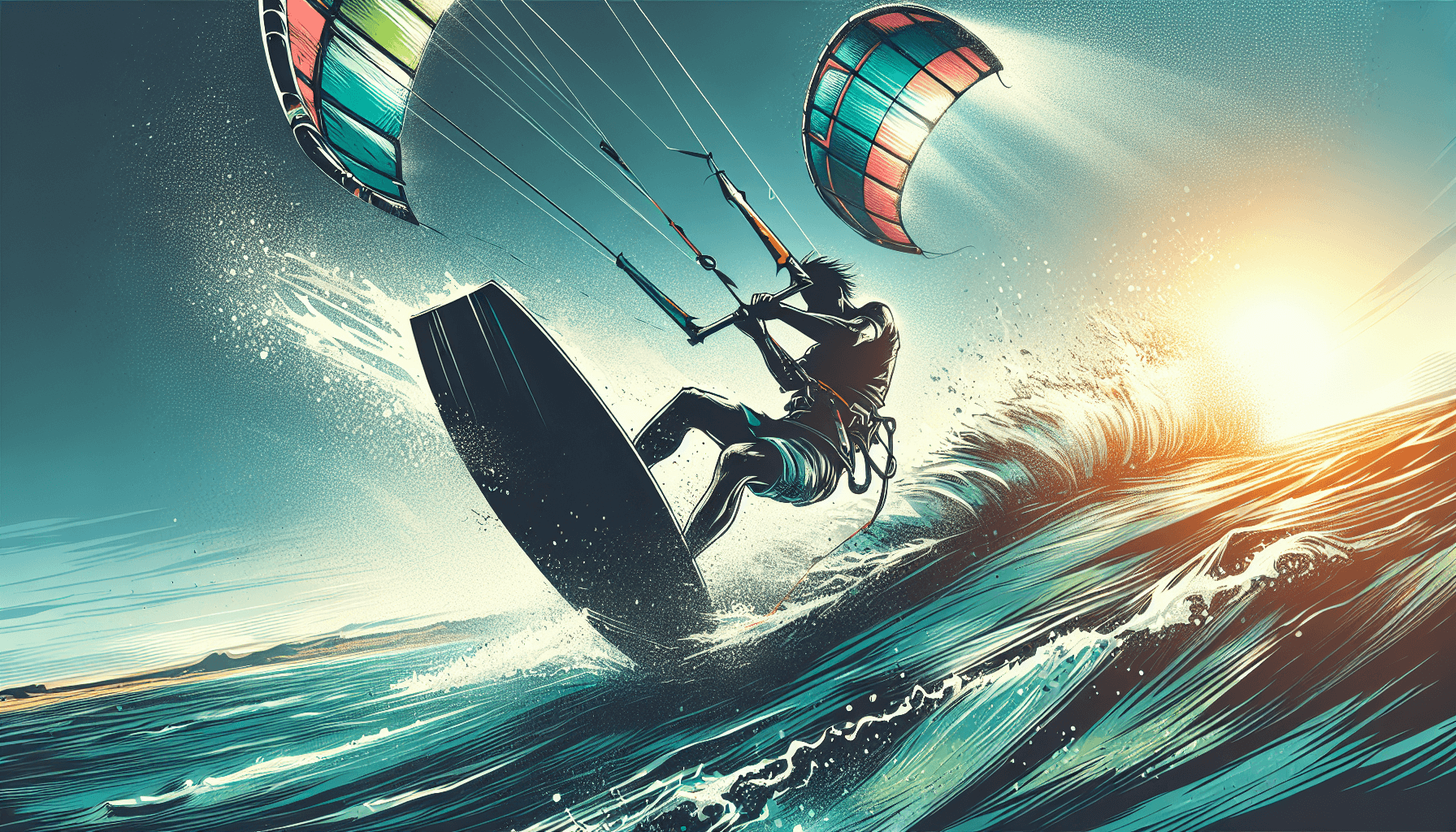
Embarking on your kitesurfing adventure, you’ll quickly discover that this sport is a dance between you, the kite, smaller waves, and the elements. Mastering this dance requires developing a swift reaction time, gaining control over the kite, and learning body-dragging techniques.
It’s how long a journey filled with challenges takes, but with every wave you conquer, you’ll be inching closer to becoming an independent kitesurfer one day.
Kite Flying Fundamentals
Before you ride the waves, you’ll need to master the art of kite flying. Just as a bird needs to understand the wind before it can fly, a kitesurfer must understand how to control the kite. The kite is your engine, lifeline, and key to harnessing the power of the wind.
Practicing kite control on land with a trainer kite is crucial to building muscle memory and improving precision. This lays the foundation for handling the kite on water, where the stakes are higher and the rewards even more exhilarating.
Moreover, understanding the wind direction and the correct kite positioning relative to the wind is vital. The kite should be flown between 10 and 11:30 or 12:30 and 2 o’clock positions relative to the wind direction to maintain a balance of lift and control.
This is also useful for upwind dragging, which we’ll delve into later. Although it takes additional time and might sound technical, it becomes second nature with practice, allowing you to ride the wind with considerable grace and power.
Body Dragging Techniques
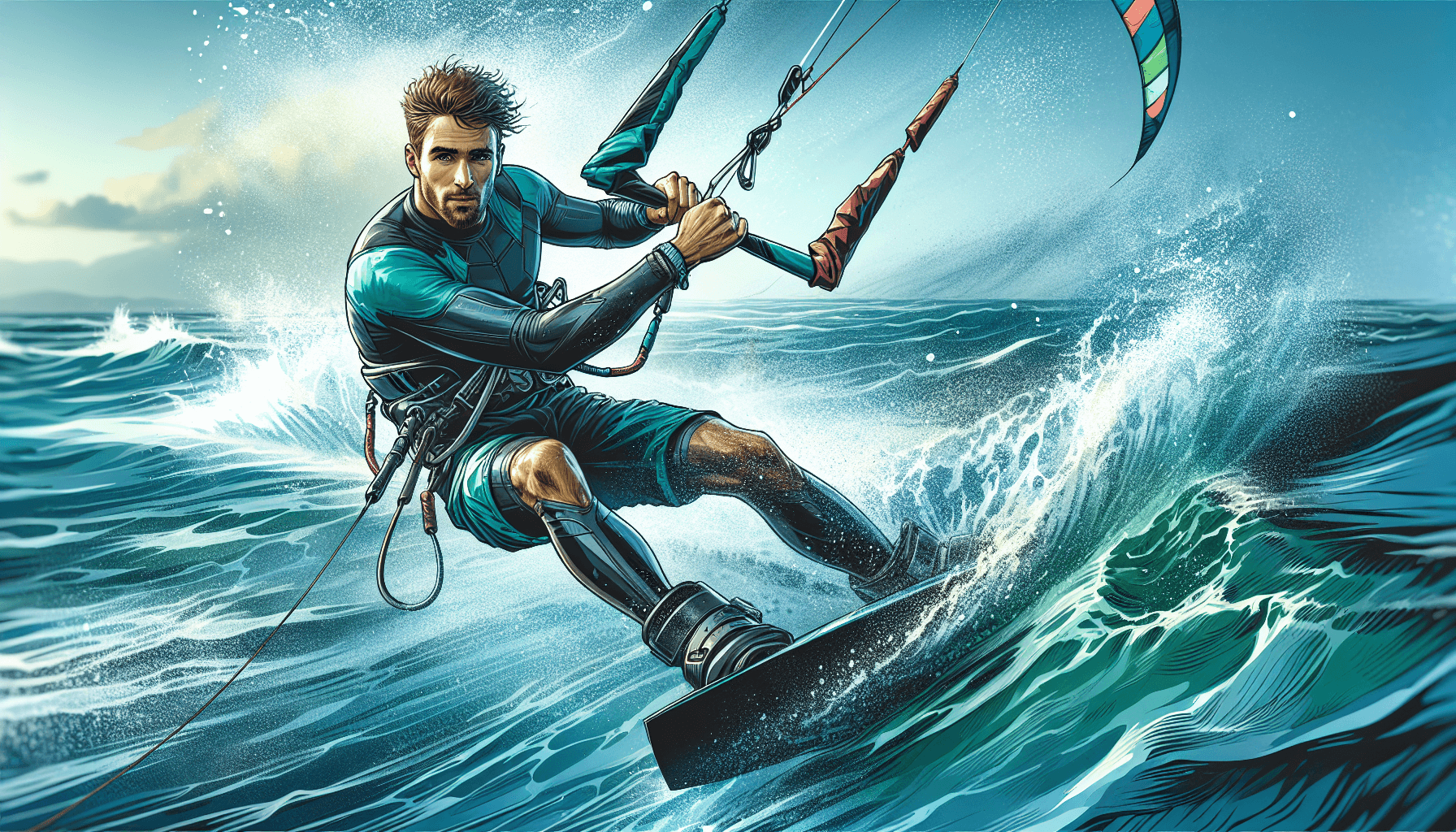
Once you’ve mastered kiteboarding and flying, it’s time to get your feet wet! Body-dragging techniques are your next stepping stone on this adventure. You use the same kiteboarding move to drag your body through the water without a board. This might sound simple, but it’s a critical skill contributing to your safety and confidence in the water.
Being able to body drag upwind is crucial in kitesurfing. It allows you to:
- Return to your board or the beach
- Ensure you can always get back to your starting point, no matter where the wind takes you.
- Retrieve your board if it becomes detached.
Effective body-dragging techniques are your lifeline in many hours of these situations.
Regular practice of these water exercises builds the comfort and control needed before progressing to riding the board.
Basic Riding Skills
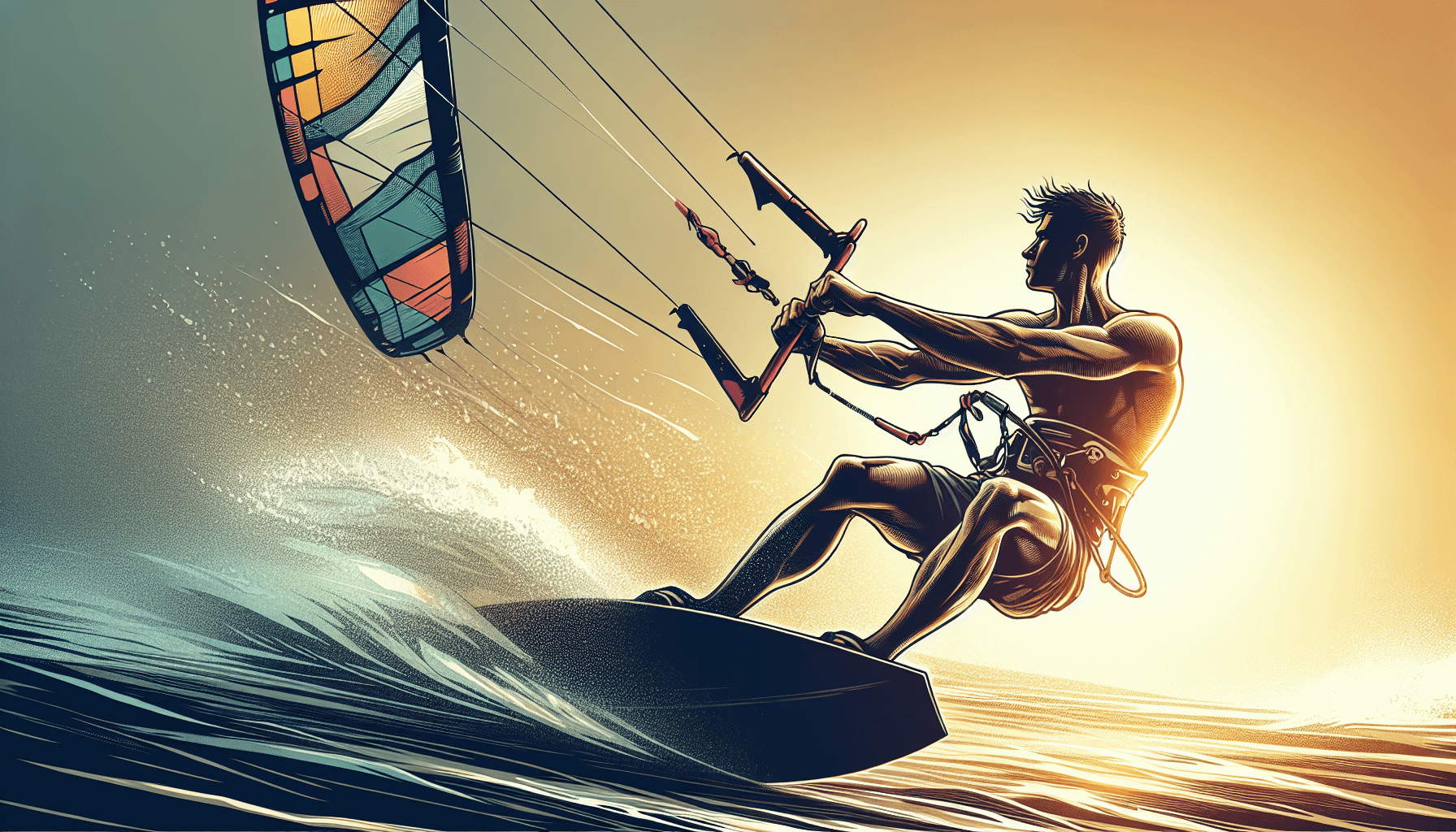
Now that you’ve mastered body dragging, it’s time to step onto the board! Here, you’ll encounter fundamental skills such as the water start, maintaining proper body posture, and learning to ride upwind.
Water starting, also known as water start riding or starting, begins at the pivotal moment in kitesurfing when you transition from floating to standing on the board. This water start is initiated with twin tip tips of the foot switches. The whole kiteboarding part is positioned in a straight line at midnight, and the water starting requires proper control as it generates enough lift to exit the water.
As you feel confident with the lift, extend your legs and lean back slightly to begin riding on the water. The correct body posture is crucial here. Your arms should be extended, your head and shoulders directed towards travel, and your hips close to the bar. One leg should be nearly straight and the other slightly bent for steering.
With all the skills, including these fundamental, basic riding ones, you’re well on your way to mastering kitesurfing! As you progress, you may want to learn to kitesurf more advanced techniques to enhance your abilities.
Factors Affecting Your Learning Pace
Just as the wind changes direction, so long does it take the pace of learning kitesurfing. It’s a dance that varies from individual to individual, depending on various factors. These include cognitive and physical processes, instruction quality, and kitesurf’s ever-changing wind conditions.
Understanding these factors can help you navigate your journey, ensuring you make the most of your time on the water and progress at a pace that suits you.
Cognitive and Physical Processes
Kitesurfing is a sport that tests both your mind and body. It’s about physical strength, coordination, balance, and quick decision-making. Simultaneously, understanding the dynamics of the wind and the kite while maintaining balance on the board requires a seamless blend of cognitive and physical processes.
Developing muscle memory, limb strength, and hand-eye coordination is crucial in the early stages of kitesurfing. Regular practice in varying wind and water conditions helps build an athlete’s adaptability and ability to maintain balance despite environmental changes. Quick environmental changes test a kitesurfer’s reaction times, demanding swift responses to maintain control, especially during unexpected wind gusts.
So, while working those muscles, remember to flex your brain, too!
Quality of Kitesurfing Lessons
The quality of instruction you receive from a qualified instructor can significantly impact your kitesurfing journey. Learning under the guidance of skilled instructors provides the essential foundation to master the equipment and the sport.
Each part of the board the kiteboard you ride has a specific function that affects performance and safety, and understanding these intricacies is crucial.
Well-structured kiteboarding lessons are critical to learning as students progress from essential kite control to more advanced maneuvers for solo kitesurfing.
A qualified instructor typically requires a comprehensive and dedicated learning plan spanning more than 12 hours for a student to gain the proficiency needed for independent kitesurfing. This underscores the importance of quality, sustained instruction, and a dedicated and enriching learning process.
Wind and Weather Conditions
In kitesurfing, the wind is your ally, engine, and, sometimes, your biggest challenge. Learning to kitesurf depends on wind conditions, and lessons require suitable wind strength to ensure safety and progression.
The average wind strength ideal for conducting lessons is between 15 to 20 knots. But what happens when the wind doesn’t play by the rules?
Variable wind conditions may necessitate adjustments to lesson plans, which can impact the overall learning pace. This is where your adaptability skills come into play. Choosing the right location with good wind conditions that match your skill level is crucial.
Flat water and shallow spots offer more accessible learning environments than deep water with big waves.
Using apps like:
- Windfinder
- Wind alert
- Windy
- MagicSeaweed
can assist in predicting wind and wave conditions for planning practice sessions.
So, while the wind may be unpredictable, you can be prepared.
Beyond the Basics: Advanced Kitesurfing Skills
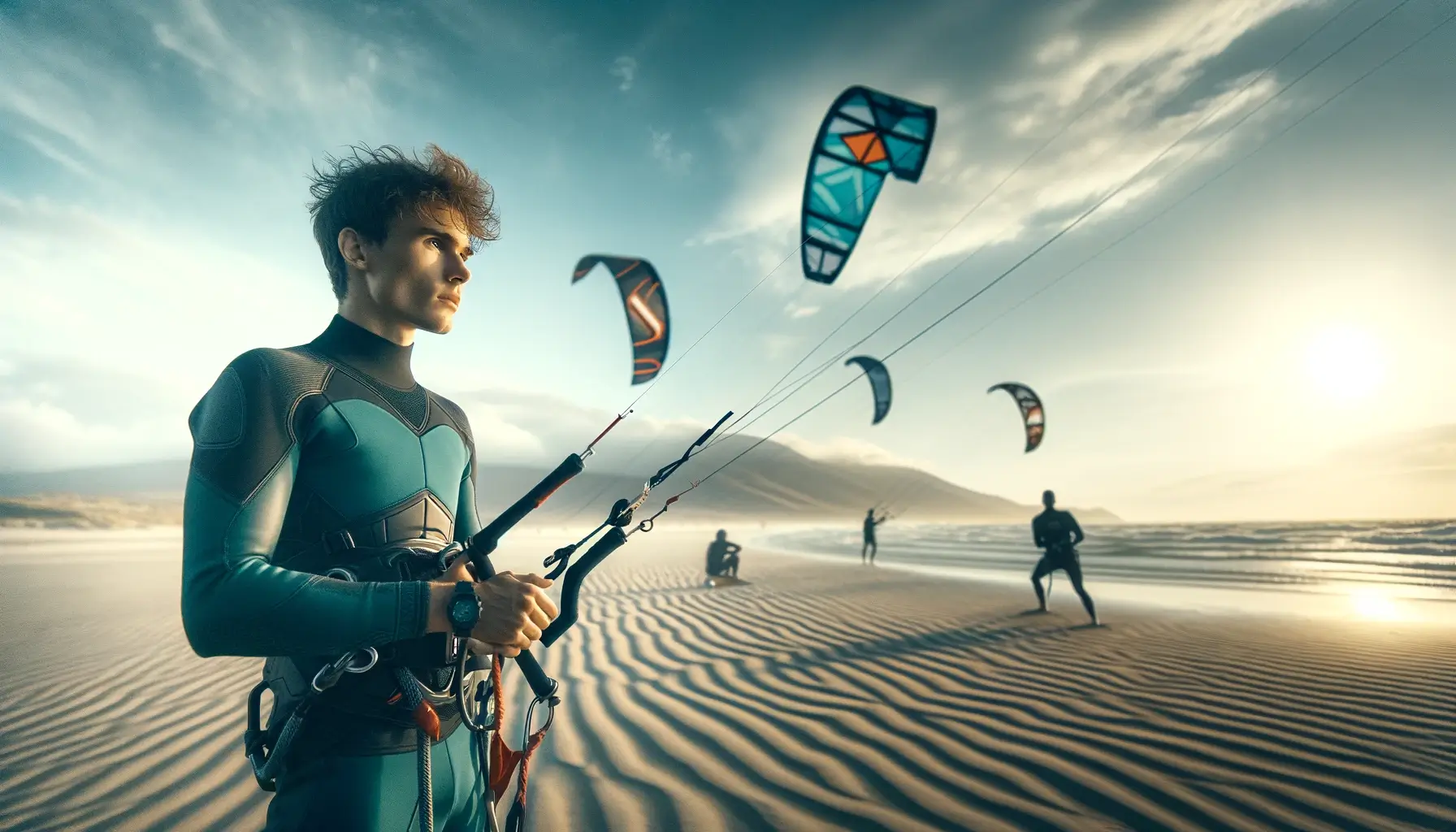
As you become more comfortable with the fundamentals, the world of kitesurfing opens up to a whole new level of excitement.
Mastering more advanced maneuvers, like jibes, foot switches, and freestyle tricks, can take from one day to two seasons, but for some, it may take one day or one to two seasons. How long does it take, but it rarely takes additional time to take two or more seasons? The thrill of executing these moves makes every moment worth it.
From here, from one day to two seasons in, we explore the exhilaration of freestyle tricks, wave riding, hydro foiling, and strapless riding.
Freestyle Tricks and Wave Riding
The adrenaline rush of performing advanced freestyle tricks and wave-riding techniques is unparalleled. As you learn freestyle tricks and master these skills, your kitesurfing experience will soar to new heights. Advanced freestyle tricks can include inverted aerial maneuvers, stylized board grabs, and dynamic moves known as board-offs.
These freestyle tricks require a unique blend of strength, balance, and precision, but the thrill of learning and executing them is an unmatched reward.
In wave riding, the challenge lies in transitioning to surfing the wave’s power. This requires mastering the following:
- toeside riding upwind to catch and ride the waves efficiently
- riding unhooked for more significant movement, freedom
- proficient kite power management due to the absence of the depower safety feature
It’s a thrilling dance with the waves that take your kitesurfing experience to a new level.
Hydrofoiling and Strapless Riding
If you’re looking for a new challenge, why not try riding a directional surfboard or kiteboard in the surf without foot straps or mastering hydrofoiling techniques? Riding a directional surfboard or kiteboard in the surf without foot straps allows optimal foot placement and greater freedom during maneuvers.
It enhances your capability for surfing smaller waves and going upwind. However, it does pose difficulties during water starts and increases the likelihood of wipeouts due to the lack of foot straps, which provide stability and secured positioning.
Hydrofoiling, on the other hand, is a game-changer in kitesurfing. It allows you to glide above the water’s surface, giving you a feeling of flying. Mastering hydrofoiling techniques takes your kitesurfing experience to new heights, literally and figuratively.
So, are you ready to learn to kitesurf, learn to kitesurf and fly, and discover just how long it takes to learn to kitesurf, how it takes to learn to kitesurf takes, how to, how it takes to kitesurf, it to learn to kitesurf?
Fun, how long does it take, and how long does it take to learn to kitesurf?
Tips for Accelerating Your Kitesurfing Progress
Now that you’re on your way to becoming an independent kitesurfer let’s explore some tips on how long it takes to learn to kitesurf and accelerate your progress.
Becoming proficient in kitesurfing doesn’t happen overnight. Just how long does it take to learn to kitesurf? It takes patience, dedication, and a keen understanding of your body and the elements. But with a focus on physical fitness, utilizing online resources, and maintaining consistent practice, you can fast-track your kitesurfing progression.
Physical Fitness and Balance Training
Regarding kitesurfing, physical fitness is about more than just strength. It’s about the right strength, speed, power, endurance, and flexibility that optimize rather than maximize muscle mass. Regular exercise and balance training can significantly improve your kitesurfing performance and reduce the risk of injury.
Exercises focusing on your core, lower back, and leg muscles are fundamental to controlling the board effectively and kiteboarding well. Balance and coordination training, such as yoga and skateboarding, can significantly affect your kitesurfing progress.
Regular exercise is crucial for maintaining kitesurfing fitness, reducing injury risk, and enhancing the ability to adapt to wind conditions, even on non-windy days with good wind conditions. So keep moving, keep strengthening, and you’ll keep progressing!
Online Resources and Homework
In today’s digital age, learning about kitesurfing is at your fingertips. Online learning resources can play a significant role in your kiteboarding lessons, accelerating your learning to the kitesurf and posted learning process. Before starting kitesurfing lessons, it’s recommended to:
- Learn about the sport
- Observe other riders
- Join an online course
- Practice flying a kite
These preparatory steps can give you a head start on teaching lessons and make your teaching lessons an advantageous learning process, making them more productive as you teach them effectively.
The Duotone Kitesurf Academy and Progression apps are excellent resources for free teaching videos and downloadable content dedicated to learning you. Watching videos of students doing desired kitesurfing maneuvers and comparing them to your attempts can give valuable visual feedback that helps identify improvement areas. So, do your homework, and you’ll ride the waves quickly!
Consistent Practice and Dedication
Behind every skilled kitesurfer is a tale of consistent practice and unwavering dedication. Regular practice is the cornerstone of mastering kitesurfing skills.
Whether the flat water to the water start-up, riding upwind, or an advanced freestyle trick, consistent practice enables you to develop muscle memory, allowing these maneuvers to become reflexive actions in the varied wind and water conditions.
But dedication is not just about the hours you put in; it’s also about the mindset. Commitment to mastering kitesurfing and perseverance through the initial dedicated learning curve accelerate progression.
Setting specific goals for each practice session can help manage anxiety and foster a sense of ongoing achievement and progression. After all, the path to learn to kitesurf mastery is not a sprint but a marathon.
Common Challenges and How to Overcome Them
Every journey has its bumps, and kitesurfing is no exception. As you navigate the sport, you may encounter equipment issues, fear, and anxiety or hit a plateau in your progress. But don’t worry. These challenges are all part of the journey, and we have strategies to help you overcome them.
Equipment Issues
The thrill of kitesurfing relies heavily on your gear, and issues can quickly halt your progress. Regular equipment maintenance is vital to avoid any hiccups hindering your sessions. Here are some key areas to focus on for gear maintenance:
- Choosing the correct flying line for your kite
- Making necessary bridle adjustments
- Checking and tightening all connections and knots
- Inspecting your kite for any tears or damage
- Cleaning and drying your equipment after each session
Taking the time to maintain your gear correctly will ensure optimal performance and safety while kitesurfing.
But gear maintenance isn’t just about performance; it’s also about longevity. Regularly drying your equipment, especially after using it in fresh water, avoiding rolling started kitesurfing down too tightly, and rinsing your gear in fresh water after use can prevent damage and extend the lifespan of your equipment. With well-maintained equipment, your kitesurfing journey will be smoother and safer.
Fear and Anxiety
Fear and anxiety are familiar companions in the journey of learning kitesurfing. The sport pushes you out of your comfort zone, both physically and mentally. However, these emotions can be managed and used to your advantage with the right strategies.
Mental preparation, visualization techniques, and relaxation strategies can help manage fear and anxiety. Regular practice in varying conditions helps build resilience and safety systems, and having trust in your equipment and safety measures can provide reassurance.
Remember that fear and anxiety are natural responses to challenges. Embrace these emotions and convert them into excitement; you’ll find yourself overcoming challenges and enjoying them, too!
Plateaus in Progress
Progress in your kitesurfing lessons is not always linear. How long does it take for you to learn kitesurf? You might hit a plateau where your kitesurf skills don’t seem to improve despite your efforts. But don’t despair; plateaus are merely signs that you’re ready for the next step in your kitesurfing journey.
Setting incremental goals, taking breaks from challenging maneuvers, and working on slightly easier skills can provide a sense of achievement and renewed motivation. Riding with peers and sharing goals can create a supportive environment encouraging perseverance and celebrating successes.
Remember, every wave you conquer brings so long that it takes you one step closer to mastery. So keep pushing, and soon enough, you’ll start riding the wave of progress again!
Overview
From mastering the basics to conquering more advanced maneuvers and tricks, kitesurfing brings the journey to becoming an independent kitesurfer filled with challenges and rewards.
With an understanding of all the skills and factors affecting your learning pace, the commitment to regular practice, and the resilience to overcome common challenges, you’re well on your way to dancing with the wind and waves. So harness the wind’s power, ride the waves thrill, and let the kitesurfing journey take you on an adventure like no other!
Frequently Asked Questions
How many days does it take to learn kitesurfing?
Learning to kitesurf and ride upwind typically rarely takes only one to two additional seasons worth many hours of surfing; it is a highly rewarding learning process that takes up to one to two additional seasons worth more per day and 15 to 20 hours of instruction. The learning time varies based on individual skills, fitness level, and environmental conditions.
Can you teach yourself to kiteboard?
Teaching sports students to kiteboard sports alone is possible, as many pioneer sports students did when formal sports schooling was unavailable. Their drive to have sports students see how fun it is harnessing the power of the wind with a kiteboard sport has led many sports students to get students to take lessons and self-teach the sport.
Can you learn to kitesurf in a week?
Learning to kitesurf in a week might be challenging for most people, as it often takes several weeks, one to two seasons, one to two seasons, two or more seasons, or even a few kitesurf sessions.
How long does it take to learn kitesurf and master it?
However, with dedication and persistence, some individuals may be able to learn to kitesurf progress more quickly.
How hard is it to learn how to kitesurf?
Learning to kitesurf well can be challenging for beginners because they must master skills like kite control, board control, and body positioning.
Despite the difficulty, many people can still learn to kitesurf and enjoy this exciting activity with proper training, practice, and gear.
What are some of the cognitive and physical processes involved in learning kitesurfing?
Learning kitesurfing involves coordination, reaction time, balance, muscle memory, and strength. These cognitive and physical processes are essential for mastering the sport.

